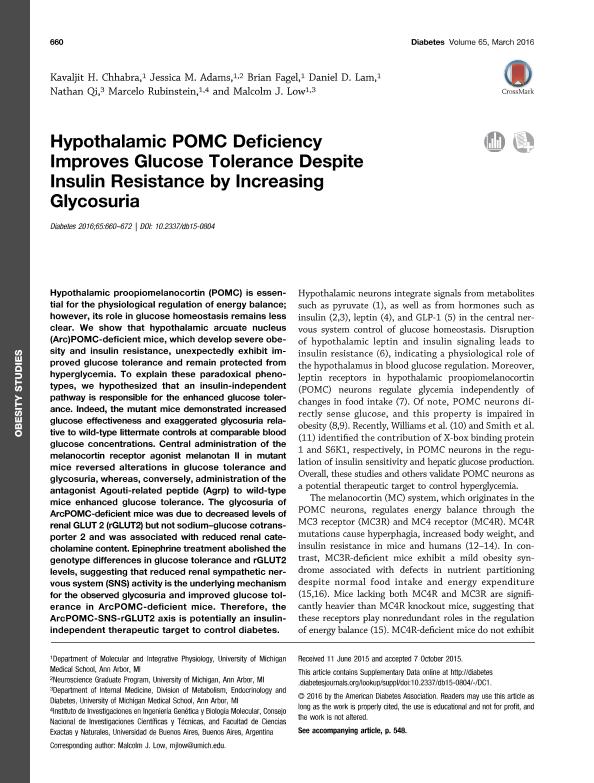Mostrar el registro sencillo del ítem
dc.contributor.author
Chhabra, Kavaljit H.
dc.contributor.author
Adams, Jessica M.
dc.contributor.author
Fagel, Brian
dc.contributor.author
Lam, Daniel D.
dc.contributor.author
Qi, Nathan
dc.contributor.author
Rubinstein, Marcelo

dc.contributor.author
Low, Malcolm J.

dc.date.available
2018-05-04T18:20:14Z
dc.date.issued
2016-03
dc.identifier.citation
Chhabra, Kavaljit H.; Adams, Jessica M.; Fagel, Brian; Lam, Daniel D.; Qi, Nathan; et al.; Hypothalamic POMC Deficiency Improves Glucose Tolerance Despite Insulin Resistance by Increasing Glycosuria; American Diabetes Association; Diabetes; 65; 3; 3-2016; 660-672
dc.identifier.issn
0012-1797
dc.identifier.uri
http://hdl.handle.net/11336/44179
dc.description.abstract
Hypothalamic proopiomelanocortin (POMC) is essential for the physiological regulation of energy balance; however, its role in glucose homeostasis remains less clear. We show that hypothalamic arcuate nucleus (Arc)POMC-deficient mice, which develop severe obesity and insulin resistance, unexpectedly exhibit improved glucose tolerance and remain protected from hyperglycemia. To explain these paradoxical phenotypes, we hypothesized that an insulin-independent pathway is responsible for the enhanced glucose tolerance. Indeed, the mutant mice demonstrated increased glucose effectiveness and exaggerated glycosuria relative to wild-type littermate controls at comparable blood glucose concentrations. Central administration of the melanocortin receptor agonist melanotan II in mutant mice reversed alterations in glucose tolerance and glycosuria, whereas, conversely, administration of the antagonist Agouti-related peptide (Agrp) to wild-type mice enhanced glucose tolerance. The glycosuria of ArcPOMC-deficient mice was due to decreased levels of renal GLUT 2 (rGLUT2) but not sodium–glucose cotransporter 2 and was associated with reduced renal catecholamine content. Epinephrine treatment abolished the genotype differences in glucose tolerance and rGLUT2 levels, suggesting that reduced renal sympathetic nervous system (SNS) activity is the underlying mechanism for the observed glycosuria and improved glucose tolerance in ArcPOMC-deficient mice. Therefore, the ArcPOMC-SNS-rGLUT2 axis is potentially an insulin-independent therapeutic target to control diabetes
dc.format
application/pdf
dc.language.iso
eng
dc.publisher
American Diabetes Association

dc.rights
info:eu-repo/semantics/openAccess
dc.rights.uri
https://creativecommons.org/licenses/by-nc-sa/2.5/ar/
dc.subject
Pomc
dc.subject
Diabetes
dc.subject
Hypothalamus
dc.subject
Glucosuria
dc.subject.classification
Salud Ocupacional

dc.subject.classification
Ciencias de la Salud

dc.subject.classification
CIENCIAS MÉDICAS Y DE LA SALUD

dc.title
Hypothalamic POMC Deficiency Improves Glucose Tolerance Despite Insulin Resistance by Increasing Glycosuria
dc.type
info:eu-repo/semantics/article
dc.type
info:ar-repo/semantics/artículo
dc.type
info:eu-repo/semantics/publishedVersion
dc.date.updated
2018-05-03T13:57:33Z
dc.journal.volume
65
dc.journal.number
3
dc.journal.pagination
660-672
dc.journal.pais
Estados Unidos

dc.description.fil
Fil: Chhabra, Kavaljit H.. University of Michigan; Estados Unidos
dc.description.fil
Fil: Adams, Jessica M.. University of Michigan; Estados Unidos
dc.description.fil
Fil: Fagel, Brian. University of Michigan; Estados Unidos
dc.description.fil
Fil: Lam, Daniel D.. University of Michigan; Estados Unidos
dc.description.fil
Fil: Qi, Nathan. University of Michigan; Estados Unidos
dc.description.fil
Fil: Rubinstein, Marcelo. University of Michigan; Estados Unidos. Consejo Nacional de Investigaciones Científicas y Técnicas. Instituto de Investigaciones en Ingeniería Genética y Biología Molecular "Dr. Héctor N. Torres"; Argentina
dc.description.fil
Fil: Low, Malcolm J.. University of Michigan; Estados Unidos
dc.journal.title
Diabetes

dc.relation.alternativeid
info:eu-repo/semantics/altIdentifier/url/http://diabetes.diabetesjournals.org/content/65/3/660.long
dc.relation.alternativeid
info:eu-repo/semantics/altIdentifier/doi/http://dx.doi.org/10.2337/db15-0804
Archivos asociados
